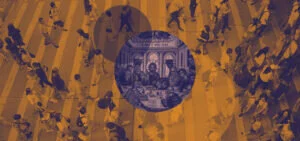It is a pleasure to participate in this symposium on Bill Craig’s new book, In Quest of the Historical Adam. But more than that, it is a responsibility: the issues are hardly of secondary importance. Indeed, for all that I think that one’s views on subjects such as whom to baptize, and what happens when we do so, matter a great deal, I think the stakes are even higher on this subject. I am not giving a book review here; I am responding to aspects of the book from the perspective of someone who has specialized in biblical studies, including Genesis.
Biblical Specifics
There are places where I would offer improvements to Craig’s arguments, and even a few disagreements. That is what I turn to now.
The Question of Genre
I am glad that Craig treats with respect my own demurrals about the word “genre” and the way it “tends to collapse important distinctions between literary form, style/register, language level, and social function.”Craig, 48, interacting with Collins, Reading Genesis Well: Navigating History, Poetry, and Science in Genesis 1–11 (Grand Rapids: Zondervan, 2018), 48–50. He nevertheless follows those who classify Genesis 1–11 as “mytho-history,” and I hope to show why this kind of classification exemplifies the difficulties I find with the notion of “genre.” Craig is right that in my approach I am “unlike most biblical scholars,” but I claim that my colleagues need to think better on this!
My reply is two-fold: first, for all Craig’s careful explanation, and his insistence that scholars need to explain our meaning to laymen, I am certain that he will be misunderstood as somehow undercutting the historical impulse in Genesis 1–11. If even as mentally nimble a figure as C. S. Lewis seems to have equivocated with this word, what can the rest of us mere mortals expect of ourselves or of our audiences?See Lewis’s essay “Myth became fact” in God in the Dock (Grand Rapids, MI: Eerdmans, 1970), 63–67.
The second part of my reply has to do with this notion of “genre.” My thinking draws on the views of the rhetorician Carolyn Miller. In her view, “a rhetorically sound definition of genre must be centered not on the substance or the form of discourse but on the action it is used to accomplish.”Carolyn Miller, “Genre as social action,” Quarterly Journal of Speech 70 (1984), 151–67. With her help we might think of things this way: Any given communication, or “text,” has a number of separate dimensions: the social function and social setting of its standard use, the literary form, the kind of language used, the style, the level of pictoriality, and so on. Since the result is multi-dimensional, it would be misleading to simplify our identification of a text as if a conglomerate designation were adequate.
An example of a wrong-headed identification comes from Steven Boyd, who discusses the “genre” of Genesis 1.Steven Boyd, “The genre of Genesis 1:1–2:3: What means this text?” in Terry Mortenson and Thane Ury, eds., Coming to Grips with Genesis: Biblical Authority and the Age of the Earth (Green Forest, AR: Master, 2008), 163–92. He thinks only two “genres” are on offer, namely “extended poetic metaphor and narrative.” Since he discerns what no one has ever seriously disputed, that Genesis 1 is a narrative, he concludes that it is to be read “as other Hebrew narratives are intended to be read—as a concise report of actual events in time-space history, which also conveys an unmistakable theological message.”I would prefer to start from the recognition that Genesis 1–11 does in fact have both important parallels to, and crucial differences from, various texts from the ancient world. This obscures entirely the different language levels of the various narratives we find in the Hebrew Bible, and forecloses discussion of what these narratives might be there to do for the people of Israel (and for the Christian church as well).
I would prefer to start from the recognition that Genesis 1–11 does in fact have both important parallels to, and crucial differences from, the various texts from the ancient world that have been offered as comparisons, especially those from Mesopotamia, a recognition that long predates the modern era. Some students of the ANE have called these “pre-history” (accounts of the earliest stages of existence, before there are any secure written records) and “proto-history” (accounts of the earliest stages of human history for which there are records),William W. Hallo, “Part 1: Mesopotamia and the Asiatic Near East,” in William W. Hallo and William K. Simpson, eds., The Ancient Near East: A History (Fort Worth, TX: Harcourt Brace College Publishers, 1998), 3–181, at 25. and I think this is better than Thorkild Jacobsen’s “mytho-history”: it has a chance of being more emic, and it does not prejudge the contents. It also makes it clearer that this is a social function of the text, while leaving open the rest of the dimensions, such as literary form and style: it can lead to clarity.
And what is that social function? In a nutshell, to shape the stance of their audiences toward their lives in the world—their worldview. It is a highly selective telling of events, a kind of front end to the story of “us,” the big story that tells a community’s members who we are, why we are here, and what the good life consists of. The audience is called to see themselves as part of this story, to use their imaginations to indwell it. In Mesopotamia the good life involves submitting to the gods by obediently occupying one’s role in a stratified society.
The literary forms include narrative poetry and “king lists,” each of which has its own rules for imaginative indwelling. The substance is events that the audiences took to be real, and the style involves a great amount of pictorial and symbolic elements in the description.
Understood this way, the social act in Genesis 1–11 is analogous, and we may call it pre-history and proto-history. Its literary form is narrative throughout; even such items as genealogies are integrated into the overall narrative structure of the wayyiqtol verb tense. The style and language level vary a fair amount, but all of it involves a good deal of what we can call “pictorial depiction.” This last term here will help us with the category of what Craig calls “the fantastic,” as I will argue below.
Of course, the Pentateuch is all one narrative, from Genesis through Deuteronomy. Hence it would be artificial to isolate Genesis 1–11 from the rest of Genesis, or of the whole Torah. At the same time, as Craig and others have noted, the flavor changes once we hit Genesis 12. However, noticing the connection guides us in discerning the social act that these chapters were aimed at performing: Each generation of Israel were to see themselves as the heirs of those who followed Joshua into the promised land, whose calling went much higher than simply taking and occupying that land. Their calling was to be part of God’s remedy for the sad distortions depicted in Genesis 1–11, by forming a community life centered on loyalty to the Lord, Maker of heaven and earth, in which the imitation of God can flourish among the members. This community was to be the vehicle by which the rest of the world would eventually come into the Abrahamic blessing. So, there must be some sense in which the faithful are to regard this as the true telling of the world’s story, as over against the alternative tellings found among both the unfaithful in Israel and the wider Gentile world. Craig will say that the classification “mytho-history” does this work. I agree that it aims to do so; but I think it renders some of the necessary details invisible. As I move to the element of the “fantastic,” I hope this will be even more clear.
The Matter of the Fantastic
Craig offers this definition: “I take it that fantastic elements are those which, if taken literally, are so extraordinary as to be palpably false” (pp. 104–05). He immediately distances his approach from the naturalistic one that sees all miracles as fantastic, and he is surely right to do so: Even if we think that thorough-going naturalism is philosophically and scientifically superior, we cannot pretend that it leads to sympathetic or emic exegesis of the biblical writers. Craig puts himself firmly on the side of the angels, the traditional metaphysic of orthodox Jews and Christians.
Craig wisely notes:
Moreover, when we deem a narrative fantastic, we presumably mean “fantastic for us.” The original author and his audience may not have found the story to be fantastic. But in light of our increased knowledge of the world, we now see that certain elements in the narrative, if taken literally, are palpably false (p. 106).
Now, this rightly makes room for a confidence that the Bible, rightly interpreted, speaks truly of the real world, compatibly with our “increased knowledge of the world.” It also assumes that the readers have pre-existing knowledge of the world, by which they are to interpret biblical statements. I suspect that it winds up, however, with an etic, rather than emic, way of reading. For example, an audience for which sacramental realism is part of their religion (in the ceremonies) will hardly find sacramental trees “fantastic.”
In any event, this category creates problems for him that he did not need to have, and I propose a way to accomplish its defensible purposes without the difficulties. His list of “fantastic nonmiraculous elements in Gen 1–11” includes such items as the six days of creation, the vegetarian diet prescribed in Gen. 1:29–30, the talking snake, the trees of life and of the knowledge of good and evil, the rivers of Eden, the cherubim, the life-spans of Genesis 5, the account of the ark and the flood,I would argue that there are good grammatical solutions to the supposed narrative inconsistencies. the table of nations, the Tower of Babel, and what he takes to be a literalistic reading of the age of the earth. This list joins his set of “inconsistencies,” which include anthropomorphisms and narrative inconsistencies (e.g., in order of events).
This is a diverse array of well-known issues, which have attracted plenty of discussion and proposed solutions to the perceived difficulties. Craig finds many of the proposals unsatisfactory, and in some cases I agree with him; but not in every case. I take his role, then, as that of a constructive friendly critic of these proposals: better to have a friend show you their faults than an opponent. But the fact that some proposals for a particular problem are unsatisfactory does not establish that all of them are. For myself, I would argue that there are good grammatical solutions to the supposed narrative inconsistencies. I would also contend that the literalists’ reading of the Genesis days and thus of the earth’s age is a literary failure, since I think the text employs an analogical portrayal of God as an agriculturalist going through his work week. That is, it uses the literary and rhetorical device of analogy and homology to recount what are presented as real events, with a view toward instilling in the people of Israel a vision for the ideal life, namely that of participating in a community that nurtures the imitation of God among its members.
And so on through the list. I have offered my suggestions on these matters elsewhere, and will not rehearse them in any detail here (e.g., Gen. 2:4–7, 19, using discourse grammar).I have done so in a number of places, including my Genesis 1–4: A Linguistic, Literary, and Theological Commentary (Phillipsburg, NJ: P&R, 2006); Reading Genesis Well.
However, I should comment on the question of the genealogies in Genesis 5 and 11. I consider it well established that these genealogies have what we can call an artificial element, in their too-tidy ten-entry arrangement—much like the fourteen-entry arrangement in Matthew 1. The narrators achieve this artificiality by omitting generations (as is unquestionable in Matthew). Craig accepts that, but also considers it “quite a different matter, however, to suggest that gaps that might have spanned tens of thousands of years each would be permitted by such genealogies” (p. 144). I agree that this is a difficulty, and that others—many of whom are well-qualified to offer such a judgment—do feel the same incredulity; but I would reply that no one actually knows whether or not this is emically so. For instance, Kenneth Kitchen, himself of at least equal qualifications, is unperturbed: he notes that “within Hebrew and related tradition, such ‘official’ father-to-son sequences can represent the actual facts of life, or they can be a condensation from an originally longer series of generations.”Kenneth A. Kitchen, On the Reliability of the Old Testament (Grand Rapids, MI: Eerdmans, 2003), 439–41. As a consequence, “we can neither date the flood before Abraham nor the creation before Noah merely by counting the Genesis figures continuously as did the worthy Archbishop Ussher in the carefree days when no evidence from outside the Bible was even imagined, still less thought about or seen.”
By his reading, people in nineteenth—century bc Mesopotamia “knew already that their world was old, very old” (his italics). A writer from a much later period, Simplicius, claims: “I have heard that the Egyptians have in writing observations of the stars from no less than six hundred and thirty thousand years, the Babylonians ones from no less than one million four hundred and forty thousand.”For the text, see Simplicius: On Aristotle on the Heavens 1.3–4, Ian Mueller, trans. (London: Bloomsbury, 2011), 59 (§117, 25–28). We may reasonably query Simplicius’s actual numbers, but they do represent the widely spread notion in the ancient world that these peoples were of great antiquity, as attested by Berossus, and other, still older, sources. I suggest that once we get to a scale of tens or hundreds of thousands, the effect of increased orders of magnitude on the imagination is negligible. Hence I do not see that we can defend an upper limit to the number of omissions, for all our discomfort; as Kitchen put it, “as for the date of the creation, why waste time number-crunching when Gen. 1:1 says it all: ‘In the beginning . . . ’—which is soon enough.”
Conversely, if our discomfort is high enough, we might count that as an epistemic cost of following Craig’s proposal. In judging these proposals, all of us make cost-benefit assessments, and choose what tensions we are willing to live with.
At the same time, I am sure that Genesis 1–11 makes abundant use of pictorial description: that is, it invites its audiences to imagine the scenes as if they were this way; accepting the persons and events as real does not forbid anyone from using imaginative portrayals of them, when what we might call “antiquarian history” is far from the author’s purpose. For example, items in these tales are described with the experience of the audience in mind, namely Israel that was familiar with the tabernacle, etc. The account is no less “true history” when it is conveyed this way, unless we decide beforehand that only a straight connection between events and their description counts asAt the same time, I am sure that Genesis 1–11 makes abundant use of pictorial description. such—a decision that ought to be highly controversial. Further, rather than testing for the “fantastic,” the ideal audience actually expects the pictorial, and simply accepts it as the divinely-approved way of portraying the events.
That this is a sound way to conceive of the ideal audience arises from the long and distinguished history among Jews and Christians of what is called audience criticism, and the relationship of the style to the needs of peasant audiences. I here give one example, and refer to documentation of others elsewhere. The premier English man of letters, John Colet (1467–1519), wrote this about the early chapters of Genesis in 1497: “Moses arranged his details in such a way as to give the people a clearer notion, and he does this after the manner of a popular poet, in order that he may the more adapt himself to the spirit of simple rusticity.”John Colet, “Second Letter to Radulphus” (1497). English translation from Frederick Seebohm, The Oxford Reformers (London: Longmans, Green, & Co., 1869), 51 (italics original).
If we view things this way, we have no difficulties with the pictures as appropriate ways of portraying the referents, and we do not entertain the possibly misleading category of the fantastic. One way to conceive of the distinction I am making is in terms of the stance the audience takes in order to cooperate with the text. And no one who had cooperated in the way I describe here, and yet uncritically took the pictures more literally than they should have done, need have felt deceived.
To be brief: I would rather use the term “pictorial description” over “fantastic elements.” Of course, as I have already indicated, I am not looking for family resemblances with myths, while Craig is. I support what I think he is trying to do overall, but with an approach that does not suffer from the dangers that I am describing. I also think it gives a sounder linguistic, literary, and rhetorical account of the way the audience is to envision the referents: the referents are real (which the label “fantastic” can obscure), and the faithful use their imaginations compliantly.
The Reading of the Fall Story in Genesis 3
I found the discussion of the fall to need more attention. Granted, Craig is writing about historical Adam and Eve, and, being concerned with “fantastic” and “mythical” elements in the stories, he has not offered a theological reading. Nevertheless some of what he finds fantastic can be accounted for differently.The interpretive tradition took the passage in the fashion that I am arguing, and we ought not discard that lightly, and all the more as that tradition is endorsed by the apostles. I contend that the Israeli literary scholar Meir Sternberg has supplied the tools for a skillful reading strategy of the Hebrew Bible—tools that show that the apostle Paul was quite properly a “Sternbergian reader” of Genesis 3.On this point see Collins, “The Place of the ‘Fall’ in the Overall Vision of the Hebrew Bible,” Trinity Journal n.s. 40 (Fall 2019), 165–84.
Craig finds the notion that the snake is “an incarnation of Satan” to be “implausible.” But “incarnation” is not the usual characterization for traditional readings of this tale. These readings see the snake as having been taken over in some way by the evil one. And this fits the Sternbergian strategy quite well. First, because every Israelite knew that snakes do not talk, any more than donkeys do—unless they have been interfered with. Second, the narrative conveys its message by showing more than by telling; and a good audience can assess that the snake’s message is unspeakably vile. And third, I have no difficulty attributing pictoriality to this passage: a snake is a convenient associate of danger in that world, and thus can serve in the role of tempter’s mouthpiece, as a creature that God made, which has been interfered with. The interpretive tradition took the passage in the fashion that I am arguing, and we ought not discard that lightly, and all the more as that tradition is endorsed by the apostles.
Christians, as well as Jews, have traditionally laid a heavy stress on the historicity of Adam and Eve. This provides a strong foundation for the common humanity that Israel shares with everyone else, and thus for Israel’s calling in the world. Among Christians more than Jews (well before Augustine tangled with Pelagius), this commonality includes the predicament that all humans find themselves in, namely their corruption and subjection to mortality, as well as their estrangement from their Maker. All humans share both dignity and damage, if you like. My point here is that the historicity of Adam is not simply about whether one particular couple existed in the genealogical relationship to the rest of us that the Bible describes (important as that is); it is about the shape of the big story we tell, with its episodes of creation, fall, redemption, and final consummation. The faithful are concerned to insist that this story is the true story of the world, and that it answers to recognizable features of human experience, which peoples everywhere acknowledge.
Natural and Supernatural in Human Origins
I am interested in what Craig thinks about the metaphysics of human origins. He says this:
One can imagine a scenario in which a regulatory mutation, perhaps divinely caused [emphasis added], occurs in a member or members of a population belonging to Homo heidelbergensis, effecting a change in the functioning of the brain that results in a significantly greater cognitive capacity (p. 337; cf. p. 376).
Others have proposed comparable scenarios; Craig’s chief contribution, as I take it, is the willingness to set this as far back as he does, with the assurance that this allows for a single ancestral couple for us all. But usually those who offer a suggestion like this agree that the upgrade involves more than simply natural factors. What is Craig’s assessment?
The addition of “perhaps divinely caused” is part of what provokes this question. After all, in orthodox Judaism and Christianity all events, including the natural ones, are in some sense “divinely caused.” Does he mean that this upgrading mutation is unexpected, or even supernatural? And does he think that we have the right, if such a change happened, to infer that its causation included more than natural factors? Is “a regulatory mutation” enough to allow for the capacities for language and reason and morality that we associate with humanity?
Near the end of the book Craig has a couple of what I judge to be very valuable sections, discussing the image of God and body-soul dualism. His relentless pursuit of logical coherence is on display, but alas! the sections are far too short to give us the kind of comprehensive treatment the earlier part of the book offered. Hence I would urge him to develop these more fully, not least to evaluate a wider range of possibilities for the image of God, and also what kind of dualism he thinks best warranted. These considerations seem to me to strengthen the case for historical Adam and Eve, at least in the sense of a distinct and more-than-purely-natural beginning. They can lend support to the kinds of evidences that Craig looks for in the paleontological record; they also lend weight to Craig’s “Quest,” since they make the purposiveness of the process that formed us an inescapable question.
The Costs and Benefits of Craig’s Proposals
A few other, much smaller, points remain, on which I would offer a somewhat different judgment than Craig does. But I pass over them in order to get to what I take to be the way in which we the public can best evaluate what to do with these proposals.
When it comes to relating the early chapters of Genesis to the subjects the scientists study, in the nature of the case we must content ourselves with scenarios. Framing scenarios takes a little imagination; I do not count that a defect. At the same time, not all scenarios are created equal, and they do not all equally address all questions. Hence, we need a disciplined imagination, to evaluate them by a kind of epistemic cost-benefit analysis.For those who want a biblical text for such things, consider Paul’s “gain” and “loss” discussion (Phil 1:21; 3:7–8); cf. Matt 16:26 et par. For example, some will set the cost of reading Genesis in anything other than a “literal” fashion so high that nothing else can be allowed to challenge that. Others, conversely, will do the opposite with the latest science. Obviously neither Craig nor I fits into either of these “camps.”
Various proposals can be successful as scenarios without being the last word in harmonization. Other scenarios may occur to those with enough imagination. Many prefer a direct, dust-to-human creation, with no ancestors for Adam and Eve, and seek ways to make that plausible. The value of scenarios is that they show that conventional Christian beliefs are not nearly as implausible as our cultured despisers make them out to be; in fact, they allow the way that our proffered Big Story makes sense of the world to shine through. It is these despisers—and the religious revisionists who adhere to them—who have unmet intellectual obligations, and not we traditionalists.It looks to me like Bill Craig has indeed provided an imaginative and serviceable tool for our toolkits.
I once heard Peter Harrison say that if certain theological views are well-founded, and fundamentally important to a well-grounded system of belief, it can be rationally responsible to maintain those views, even if, for the time being, the science seems to call them into question. I believe he was right, at least for these basic beliefs about the origin of humankind and of sin. These are too well-connected to the kinds of experiences that are universally accessible and all-but-universally recognized. Sometimes, if we wait, new light will come in the scientific thinking. And sometimes, as well, someone with enough imagination will propose a workable scenario that helps us past an apparent hump. It looks to me like Bill Craig has indeed provided an imaginative and serviceable tool for our toolkits. We ought all to be thankful for this demonstration, first that exegesis requires our best application of both imagination and mental rigor, and second, that the sciences are used illegitimately when they are stated in such a way as to oppose all forms of certain central Christian beliefs.
I must finish, leaving much unsaid. But I will not leave unsaid my gratitude for what Craig has done, and its potential contribution to good thinking about science, faith, and the good human life.








Comments
Be the first one to make a comment!